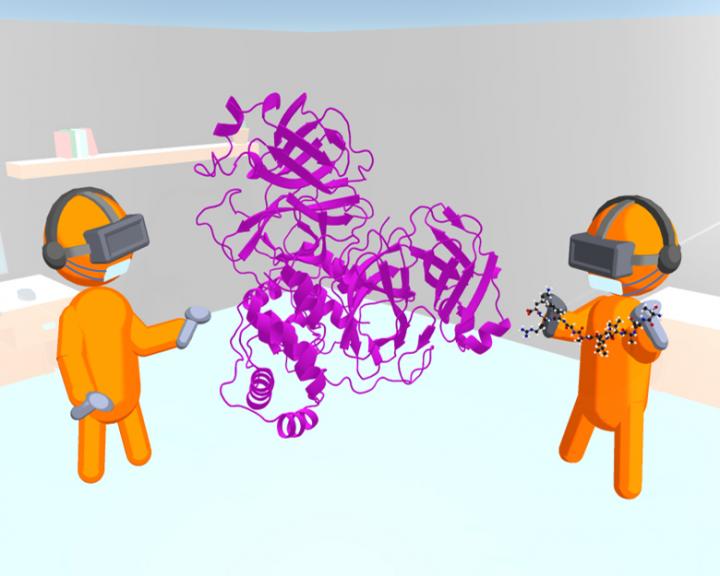November 16, 2020 -- A new virtual reality tool offers scientists a chance to "step inside" the SARS-CoV-2 virus's main enzyme responsible for replication and manipulate it in atomic detail to find ways to shut it down. The technology could enable researchers in different locations to collaborate on drug development within a virtual environment.
The new tool is intended to help scientists pursuing structure-based drug design approaches in combating COVID-19. The details of the new technology were reported in the Journal of Chemical Information and Modeling on November 11.
The SARS-CoV-2 virus's main protease (Mpro) is the enzyme largely responsible for the virus's replication. Drugmakers around the world are on the hunt for molecules, called enzyme inhibitors, that stop Mpro from working.
Because the original SARS virus Mpro and SARS-CoV-2 Mpro share 95% of their structure, scientists already have an understanding of how Mpro works, giving them a head start in the race for an effective enzyme inhibitor.
The new tool, named "interactive molecular dynamics in virtual reality" (iMD-VR), was designed to give scientists an experimental approach to test how well compounds bind together. This offers an important advantage in the search for drugs against Mpro since a key predictor of an enzyme inhibitor's effectiveness is how tightly it binds to its target.
"We've shown that interactive virtual reality can model how viral proteins and inhibitors bind to the enzyme," said co-author Adrian Mulholland, PhD, of the University of Bristol School of Chemistry, in a statement. "Researchers can use this tool to help understand how the enzyme works, and also to see how potential drugs fit into the enzyme. This should help design and test new potential drug leads."

In earlier work, the authors demonstrated that iMD-VR is an effective method for interactive modeling of the "docking" of small molecule drugs into their protein targets. Molecular docking -- a technique used by researchers to make predictions on how well a protein (enzyme) interacts with small molecules (ligands) -- is used in drug design to identify "hit" molecules that would be able to bind and inhibit key enzymes.
Existing scattershot approaches to docking, which rely on high-throughput screening of promising ligands, result in many false positives. The iMD-VR system, which incorporates a physically rigorous molecular dynamics simulation, allows for more dynamic and flexible manipulation of structures, enabling the user to discover favorable binding modes interactively.
In this study, researchers tested the effectiveness of the iMD-VR system by using it for two docking experiments. In the first, they docked a small drug-like inhibitor, X77, into an apo (uncomplexed) SARS-CoV-2 Mpro structure. In this experiment, the iMD-VR user interactively pulled X77 out of Mpro and then manually reintroduced it into the binding site. The user was able to recreate the X77 bound structure with high accuracy, demonstrating the effectiveness of the tool at recreating stable binding poses of ligands of the SARS-CoV-2 Mpro.
In the second experiment, the researchers used iMD-VR to dock an oligopeptide substrate (11-mer oligopeptide) into the original SARS-CoV Mpro. The oligopeptide substrate was chosen because it is processed by both the SARS-CoV and SARS-CoV-2 Mpro.
This experiment demonstrated the advantages of the iMD-VR tool, namely that it allows the user to manipulate long, flexible molecules with many rotatable bonds. Conventional docking methods often fail once the complexity of the ligand structure exceeds 10 rotatable bonds.
The experiments showed that even nonexpert users can use iMD-VR to recreate experimentally observed structures of protein-ligand complexes with accuracy comparable to conventional docking methods, according to the authors. "With a little practice, researchers can dock ligands to proteins in a few minutes," they stated.
The iMD-VR framework is intended to complement rather than replace conventional high-throughput docking, for example to test and refine candidate structures based on human intuition, according to the authors.
The system is also intended to enable researchers to share models and collaborate in new ways.
"We are sharing these models with the whole community," Mulholland said. "An exciting aspect is that it also allows researchers to collaborate in new ways: using cloud computing, they can tackle a drug discovery problem together at the same time when they are in different locations -- potentially even in different countries -- working simultaneously in the same virtual molecular environment."
The iMD-VR tool runs inside NarupaXR, a free, open-source framework for iMD-VR.
Do you have a unique perspective on your research related to drug discovery and development or bioinformatics? Contact the editor today to learn more.
Copyright © 2020 scienceboard.net


